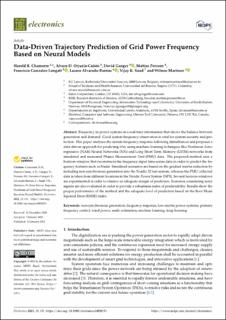Data-Driven Trajectory Prediction of Grid Power Frequency Based on Neural Models
Chamorro, Harold R.; Orjuela-Cañón, Alvaro D.; Ganger, David; Mattias, Persson; Gonzalez-Longatt, Francisco; Alvarado-Barrios, Lazaro; Sood, Vijay K.; Martinez, Wilmar
Peer reviewed, Journal article
Published version
Permanent lenke
https://hdl.handle.net/11250/2727326Utgivelsesdato
2021Metadata
Vis full innførselSamlinger
Originalversjon
Chamorro, H. R., Orjuela-Cañón, A. D., Ganger, D., Persson, M., Gonzalez-Longatt, F., Alvarado-Barrios, L., Sood, V. K. & Martinez, W. (2021). Data-Driven Trajectory Prediction of Grid Power Frequency Based on Neural Models. Electronics, 10(2), 151. https://doi.org/10.3390/electronics10020151Sammendrag
Frequency in power systems is a real-time information that shows the balance between generation and demand. Good system frequency observation is vital for system security and protection. This paper analyses the system frequency response following disturbances and proposes a data-driven approach for predicting it by using machine learning techniques like Nonlinear Auto-regressive (NAR) Neural Networks (NN) and Long Short Term Memory (LSTM) networks from simulated and measured Phasor Measurement Unit (PMU) data. The proposed method uses a horizon-window that reconstructs the frequency input time-series data in order to predict the frequency features such as Nadir. Simulated scenarios are based on the gradual inertia reduction by including non-synchronous generation into the Nordic 32 test system, whereas the PMU collected data is taken from different locations in the Nordic Power System (NPS). Several horizon-windows are experimented in order to observe an adequate margin of prediction. Scenarios considering noisy signals are also evaluated in order to provide a robustness index of predictability. Results show the proper performance of the method and the adequate level of prediction based on the Root Mean Squared Error (RMSE) index.

